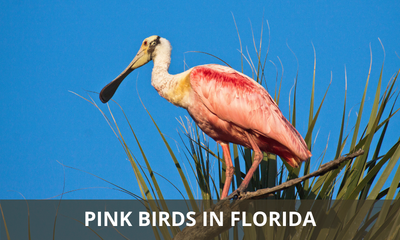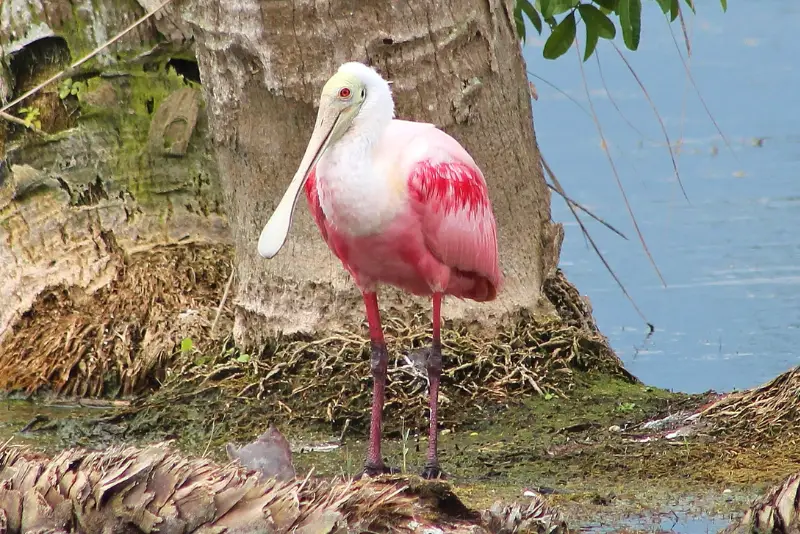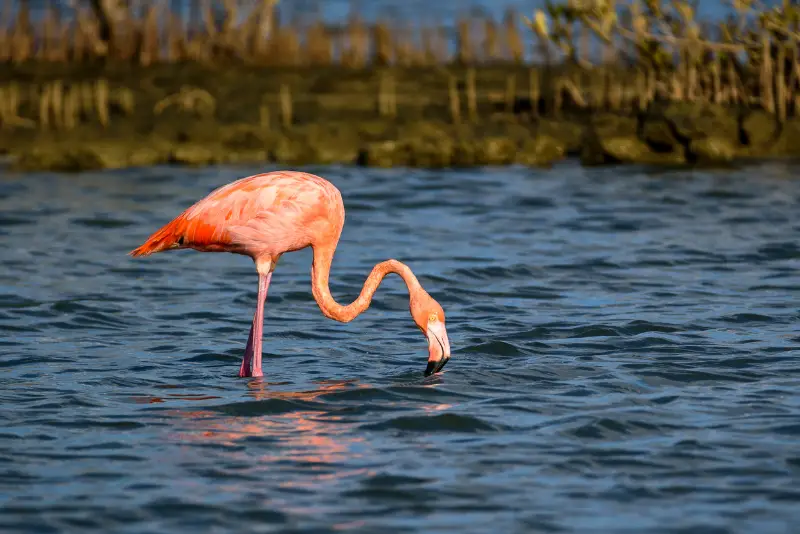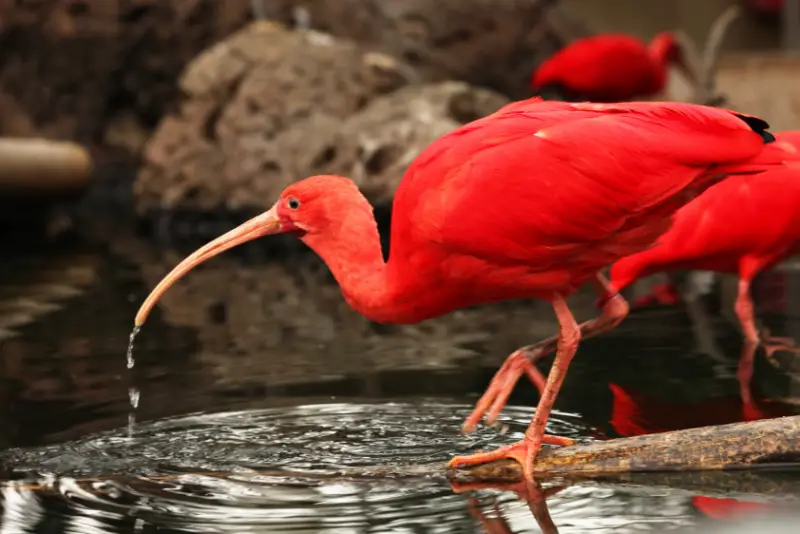3 Types Of PINK BIRDS In Florida (ID Guide With Photos)
Did you spot a pink bird in the sunshine state? In that case you’re probably wondering what species you saw.
But identifying these birds is not as easy as it might seem, since there are three different bird species in the sunshine state that are entirely or partially pink!
If you aren’t sure what pink-colored bird you saw, we’ll help you cover all the possibilities here in this article.

What types of pink birds are found in Florida?
There are currently three types of pink birds that are found in Florida:
- Roseate Spoonbill
- American Flamingo
- Scarlet Ibis
Out of these three species, only the Roseate Spoonbill is native to Florida.
The other two bird species have been introduced to Florida (either on purpose or by accident – as escapees from zoos).
However, all three bird species can be regularly seen in Florida, so you need make sure you can distinguish between them.
The 3 types of pink birds in Florida
Now let’s dive into the details, and take a closer look at each of these birds in order to get the full scoop:
1. Roseate Spoonbill
Scientific name: Platalea Ajaja

Roseate spoonbills are medium-sized wading birds, similar to storks but smaller.
The adults are white on their backs, neck, and face, while the rest of their plumage is bright pink.
However, it should be noted that the exact shade of pink can vary a lot, depending on its diet. The more shrimp it eats, the more pink its plumage becomes, due to the carotenoid substances found in shrimp.
Whilst these birds are most common in South America, they are also found as shore birds in Florida and the southern United States, where they are known for their beautiful plumage.
These birds are sometimes mistaken for flamingos because they look similar, but keen ornithologists will notice that flamingos have a short, angled bill, while spoonbills have a long, spatulate bill that has a broad “spoon” at its end.
Occurring in both freshwater and saltwater habitats, Roseate Spoonbills are commonly seen on lakes, ponds, rivers and estuaries. They spend most of their lives in the water.
Roseate Spoonbills feed by swinging their bill back and forth as they wade through shallow water, which allows them to sift small animals out of the water.
Their diet consists of small crustaceans, insects, worms, snails, frogs, fish and mollusks.
This pink bird in Florida usually builds nests near the shoreline, often in trees, which provides them with quick access to foraging grounds.
The breeding season starts in march, and their nests are built by piling up sticks and grass. Roseate Spoonbills lay around 2 to 5 eggs, which both parents take turns to incubate.
Once the chicks hatch after about 21 days, feeding responsibilities are shared, and the chicks are fed by regurgitating food into the young birds’ mouths.
This continues until the chicks are old enough to leave the nest and forage for themselves.
Roseate spoonbills live in the tropical regions of South America, Central America, the Caribbean, as well the Gulf Coast and southern parts of the United States.
This species has made a remarkable recovery after being driven close to extinction due to intensive hunting in the 1800s.
Due to its steady population growth within its breeding areas in the southern USA, it has started expanding its range, and is even observed far north of its range on occasion.
The best place to see these gorgeous birds in the sunshine state is in the Everglades, which has more than 200 breeding pairs.
2. American Flamingo
Scientific name: Phoenicopterus ruber

This pink bird is a member of the flamingo family, Phoenicopteridae, found in North and South America.
When it comes to Florida, no bird species is more synonymous with the culture of the state than the flamingo, which is somewhat ironic, given that it is not a native bird of the state.
Somewhat stereotypically associated with Miami, the American Flamingo is found along the coasts of the Caribbean, the Gulf of Mexico, as well as northern parts of South America.
The northernmost breeding population of American Flamingos is found in the Florida Keys and several other parts of southern Florida.
It is thought that the population of American Flamingos in Florida is descended from birds that escaped from parks and zoos. It can now be seen in the Everglades and other areas with salt flats.
The beak has a 45-degree curve, which allows flamingos to scoop algae, molluscs, plants, worms, insect larvae, small crustaceans, and shrimp out of the water.
Shrimp in particular are a key staple of their diet, and this is what gives flamingos their reddish pink coloring.
With a distinctive reddish pink head and neck, they can commonly be seen standing on their long legs whilst feeding in shallow water, which is where they’re predominantly found.
Flamingos are large birds, standing usually about 3 to 4 feet tall. Like other birds they have feathers for protection, and with two toes on each foot, making balance an occasional issue when walking.
This led to their distinctive walk, wherein they move forward first with one leg, then the other, to help them balance.
These birds mate for life, and the male will stay with his partner for years, offering support and protection against predators, often only moving on when the partner dies.
Flamingos lay their eggs on mud mounts. Each nest only holds a single egg, which is incubated by both parents.
A flamingo egg hatches after about 28 to 32 days of incubation. After hatching, the chick has a fluffy tail and stays in its nest for about 7 to 11 days.
3. Scarlet Ibis
Scientific name: Eudocimus ruber

Scarlet ibises are large birds, standing up to 2.5 feet tall, and with a weight of up to 4 pounds.
They have long legs, as well as a long beak that is curved downwards. Adult birds are almost entirely scarlet red, except for their black wing tips.
Despite being mostly native to the northern coast of South America, and Caribbean islands, these birds have quite recently colonized parts of southern Florida.
The population of Scarlet Ibises in Florida is probably descended from birds that escaped from parks or zoos.
Scarlet ibises live in groups, forming loose colonies that suit their sociable, gregarious natures.
Oddly enough, they may even join other species such as egrets or herons that live in the same habitat.
This aquatic bird prefers water habitats with lots of vegetation, such as swamps, marshes, mangroves, as well as forests close to water.
Staying local, roosting together for warmth at night, and not flying very far, these birds live off a steady diet of insects and small aquatic invertebrates.
A male scarlet ibis will defend a territory against other males, chasing them off if he sees them trying to mate with any female under his watch.
This protective nature extends to the offspring too, with both sexes taking care of the young, feeding them, protecting them, and teaching them how to forage for food.
This species will mate with the American White Ibis, and the resulting offspring are various shades of pink. The hybrids, however, are sterile.
The best place to see this bird is in zoos or aviaries, such as the Bush Gardens in Tampa.
While it can be seen in the wild at times, these individuals are either vagrant birds from South America, or escaped birds from local parks.
What is the most common pink bird found in Florida?
The most common pink bird in the sunshine state is the Roseate Spoonbill.
The Audubon Society has recorded more than 1,100 breeding pairs of the Roseate Spoonbill in Florida, and the population growth has been on an upwards trend.
This is a very positive development, given that this species was close to extinction in North America during the nineteenth century.
What are white birds with pink wings in Florida?
If you see a white bird with pink wings in the sunshine state, you’re probably looking at a Roseate Spoonbill.
These birds have a white back, neck and face, while their wings are deep pink. Their legs and tail are also pink.
The best way to definitively identify these birds is by their spatulate bill, which has a round flattened area at the end that looks like a spoon.
Conclusion
Thanks to its tropical climate, proximity to the Bahamas and Cuba, as well as a series of imports over the years, Florida now boasts a wealth of exotic birds that have settled in the area, only helping to reinforce the lavish, care-free image that the state purveys.
Why not check it out, and see how many of these beautiful creatures you can spot?
